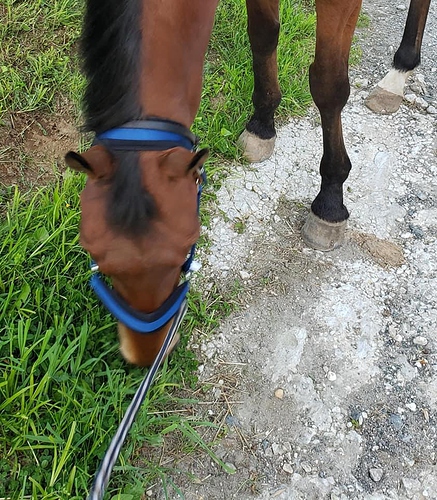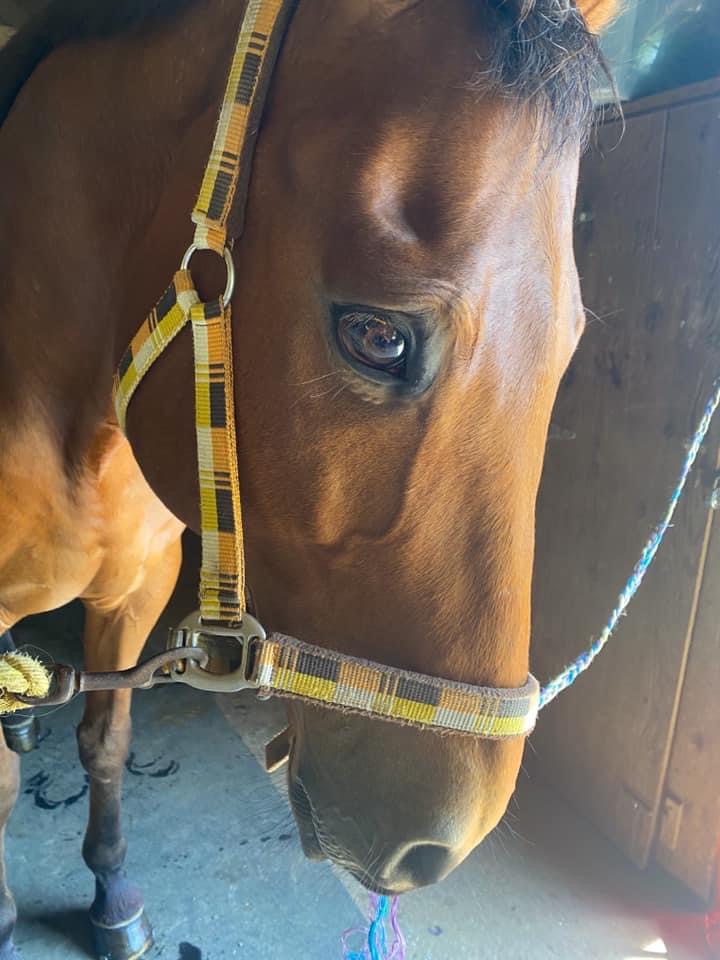Thank you, I really do appreciate it. I will be keeping this updated as we progress and see what happens and if things change.
Hearing the mentions of back sore, loss of topline, intermittent bucking, stumbling behind, and worse under saddle, have you considered doing back Xrays to check for kissing spine?
We do have x-rays of his back. He had two vertebrae that were closer than the others, but they were not touching at all, nor did they show that they had been rubbing or touching in the past. I considered that as well and we may do anther round of x-rays to see if they have changed at all, but they were well within normal limits.
Just chiming in to say if you need anything like an appointment with a neurologist, let me know. I am happy to help in any way that I can.
Many thanks,
Em
That’s so amazing of you, thank you so much!!
For a horse low in vitamin E and if he does have EPM (I’m still skeptical on this based on the info you have provided), I would not be working him hard on this proprioceptive and strengthening exercise right away. Give the vitamin E supplementation and Marquis a chance to work first. You can’t challenge him proprioceptively by lunging in the Equiband without his neuro pathways being able to function normally. Maybe start with some hand walks in the Equiband in this phase.
Just because this vet is an FEI approved vet doesn’t mean they know anything about neuro or neck issues. Lots of sports vets don’t because honestly it’s still an area that’s fairly new to being considered as part of a performance problem. And when the horse seems to have actual neuro deficits, the best place to go next is not a sports vet but a neurology specialist. Your regular vet is great at sending off blood to check E, Se, for infections like EPM, and maybe she has helped EPM horses rehab before. But it sounds like you have passed the point where it’s time to be referred to a specialist.
When my horse with neck issues was first diagnosed, the field team took some images and we all (from me, never seeing neck images before to 2 other vet teams—4 vets total—present) went, uh, WTF is THAT? And then the next step was a combined full service appointment with neuro and sports medicine so they could really evaluate the imaging and nerve tests (neuro) in conjunction with the movement evaluation (sports med). And then they put their heads together and came up with a game plan for treatment and rehabilitation. For a horse who passed a very involved neuro evaluation within normal limits. I mean, my current horse just did a very dumb thing and fractured his scapula. My sports vet and equine rehabilitation specialist and board certified surgeon was having trouble interpreting what we were finding to the point we had the radiologist on FaceTime since horse was at home as it was not ideal to trailer to the hospital for this evaluation.
As others have mentioned, the history does not suggest acute infection, nor does the blood work seem to support that. But I suppose he could still have EPM, and Marquis is unlikely to hurt anything other than your wallet. In a case where there is known pathology, this sets off some alarm bells. And that you’ve had trainers put you with now potentially a third significantly neuro horse makes me think that you need someone knowledgeable and present for this horse’s care to really step up and take ownership of this case, make a plan that is achievable (for you and the horse), and help guide you through this process.
You are such an asset to this forum, Em. 
Separate and apart from this horse or neuro conditions, I am surprised anyone just throws on the Equicore and is off to the races. I love the thing, and I used it effectively to rehab a horse post kissing spines surgery. EVERYONE in my barn then bought one. They’re used religiously by us.
BUT it’s a learning process getting the horse used to the feel. The company that makes the Equicore tells you to work up slowly to actually exercising the horse in it-- first just walking so the horse gets used to the feel of it loose, then working up to walking in full adjustment, etc.
AND… goddamn… it’s HARD WORK. We only use it a couple times a week and see big differences in the horses, but it would make them really sour and sore if we used it 5/6 days a week (especially with no wean up period). They really do WORK HARDER with it on. You could put me blindfolded on my horse and I could tell from 3 steps of walk if he had it on or not, he has to work harder through his whole body when he’s in the Equicore.
It’s TERRIFIC tool. I recommend it wholeheartedly for horses with issues and horses without. But I can’t imagine just throwing it on and then it becomes a daily thing. It’s not just a pretty ear hat or some trendy pair of brushing boots… it has an effect on the horse’s body and it takes some getting used to and ups the ante physically.
See, it’s these two somewhat contradictory statements that worry some of us.
It’s great that you are following your vet’s instructions and of course we don’t know you or your horse IRL. We can only offer observations and suggestions based on the information that you have provided us. The info you have provided - inconclusive EPM blood work, muscle wasting, inconsistent neuro-like symptoms, yet recommendations to go into “bootcamp” like work just all seems a little inconsistent. And it very well may be that your definition of some of these terms/conditions are not what some others, myself included, think of when those terms are used.
We all really do want the best for both you and your horse.
Please tell me this is your old barn/training situation. A trainer telling you that “it’s this horse or you’re on your own” with a horse that you were obviously not comfortable is a huge red flag. You’re paying a trainer to be your advocate, not bully you into a situation where you got hurt.
I love my Bemer.
I bought it last summer and have used it on a variety of horses with a lot of success.
I personally use mine before my rides with the most positive results. I think it really jump starts my warm ups. At shows I also see a significant benefit. One of the best things is that the Bemer is kind of idiot proof. It is really hard to misuse the set imo.
I love mine so much I decided to be a distributor. If you have any questions I would be happy to help you!
Ya, that was the old barn situation. I also am not the best with describing some of what is happening but, I appreciate that you want what’s best and believe me when I say that my vet has an internal medicine specialist and further diagnostics lined up following findings on his two week check up.
While the Equicore people do say to build up the length of time that you work the horse in it gradually, they also tell you to use it daily for up to 3 months to build the horse’s core strength and then drop down to 1-2 days/week for maintenance. I don’t think the OP said how long her Equiband sessions are, but using it daily from the start isn’t actually a red flag as long as they are short sessions.
That’s what I am doing, short walk and trot only for about 20 min and that’s what he gets for the day with it. It’s not super intensive bootcamp, I used that term because we are focusing on his strength and muscle more so than just my riding him. First we lunged him, just walking in it and then got on and just walked in it for like 15 min on a loose setting and we are gradually building him up in it, still looseish and gradually incorporating more and longer trot. Thanks for clarifying!
hi, could you discuss this more with me over PM?
In your updates you were thinking about switching feeds for more amino acids, if you don’t want to do that, Uckele Tri Amino is a good supp, supplying the 3 baseline amino acids.
I have a very easy keeping Fjord who does a very hard job (comb. driving) and building appropriate muscle while feeding grass hay and a cup of ration balancer is my daily struggle. Elevate E and Tri Amino are my baseline supps.
thanks for that insight!! The vet and all has been kinda crazy and we dont seem to be getting anywhere.
I’ve been down that road before and it’s painful, but I’m also familiar with sports medicine in horses. Unfortunately it often comes down to trial and error/process of elimination for the vets. That doesn’t mean the vet is not capable, but rather that horses can’t tell us what’s wrong, we don’t have extensive diagnostic machinery like we do in humans, and riders are sometimes very imperfect evaluators of problems, primarily because in these really tough cases you get a lot of compensatory lameness/change in gait. It can take a long time to work your way back through all the problems that arise from the core problem, and then even then the core problem dx can remain challenging.
ya, and I guess that is the route we took with process of elimination. We did the Marquis for EPM and he finished that yesterday. I may start a new thread on this, I just really would like some insight from others about this that is more recent following treatment and veterinary analysis.
Hopefully I am not derailing OP’s thread too much: can you explain what you see here? I understand it’s in slo-mo but honestly as horses don’t move in slo-mo I’m having a hard time knowing what I’m looking at. Horses in slo-mo videos look irregular no matter what.
On the subject of PEMF, I found it incredibly helpful post-fracture.
My gelding fractured his nasofrontal bone straight across right at the start of the Pandemic. He had a nasty fracture callus from the injury, and oral/topical NSAIDS weren’t making a dent. Since PEMF has shown good results in human studies for non-union fractures, we gave it a go. By the time the barn re-opened to boarders, you could barely tell he’d done a number on himself.
Mid-stage/during treatment:
After (sad about eye wash for the buttercup petal in his eye):


